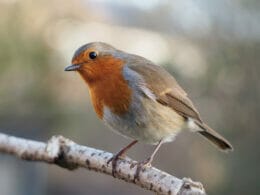Ohio has a lot of offer for birders, with Lake Erie to the north, the wilds of West Virginia to the south and the forests of Michigan to the north west. There are many habitats suitable for birds. In this post we will be trying to find 10 yellow birds in the state.

State of Ohio
Ohio is a relatively small state, 34th out of the 51 in total. However, it is full of geographical features with 5 distinct regions. Firstly, in the north is Lake Erie, the only Great Lake bordering the state. The Great Lakes Plain is south of Erie and the Till Plains to the west are important agricultural areas. South and east of the Till Plains is the Bluegrass Region which consists of rolling hills and more fertile soil. Lastly, on the eastern side of the state is the Appalachian Plateau, an impressive area geogically speaking.
Birds of Ohio
Ohio is another state located within the Mississippi Flyway, a vital corridor between the Great Lakes Region and South America that migrating birds use each spring and fall. Ohio is a stopping off point for some to rest and feed, while others stay through the breeding season. Ohio also has a good amount of waterways, lakes and wetlands so waterbirds and waders can also be found across the state. Here is our pick of 10 yellow or partly yellow colored birds.
Ten of the best
Yellow-rumped Warbler (Setophaga coronata)
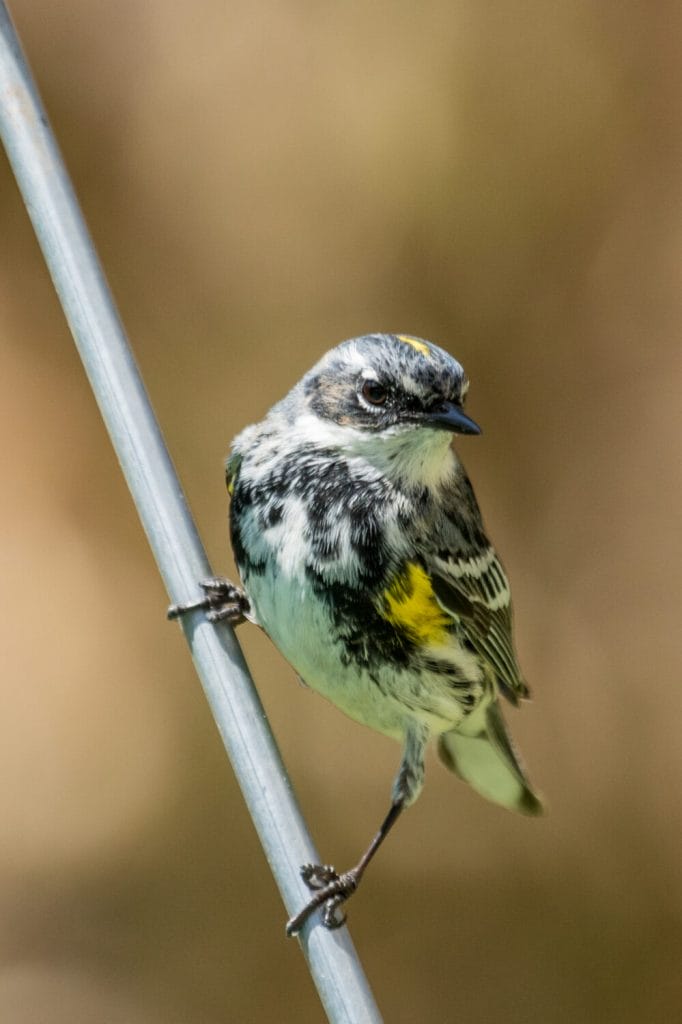

Identification and Size
The Yellow-rumped Warbler has 2 distinct subspecies. The photos above are the Myrtle variety with no yellow on the the throat and this is the eastern form, found in Ohio. It is a black and white warbler with bright yellow on the rump, a partially hidden crest on the head and on the sides of the breast. The female is similar but more brown.
Length: 4.7 – 5.5 inches
Wingspan: 7.5 – 9.1 inches
Weight: 0.4 – 0.5 ounces
Distribution

The Yellow-rumped Warbler is migratory but can be seen in most months of the year across the whole state.

Call
Diet
In the breeding months, the Yellow-rumped Warbler eats insects and invertebrates. During the migration and winter periods, it will also eat available fruits.
Interesting Fact
There is a definite pecking order for warblers. The Yellow-rumped Warbler will give way to Palm, Black-throated Green and Magnolia Warblers, but will assert themselves over Blackburnian and Pine Warblers.
Greater Yellowlegs (Tringa melanoleuca)


Identification and Size
The Greater Yellowlegs is a large wader with distinctive long, bright yellow legs. The body is a blend of whites and gray patterning with a long, bi-colored bill.
Length: 11.4 – 13 inches
Wingspan: 23.6 inches
Weight: 4.5 – 7.7 ounces
Distribution
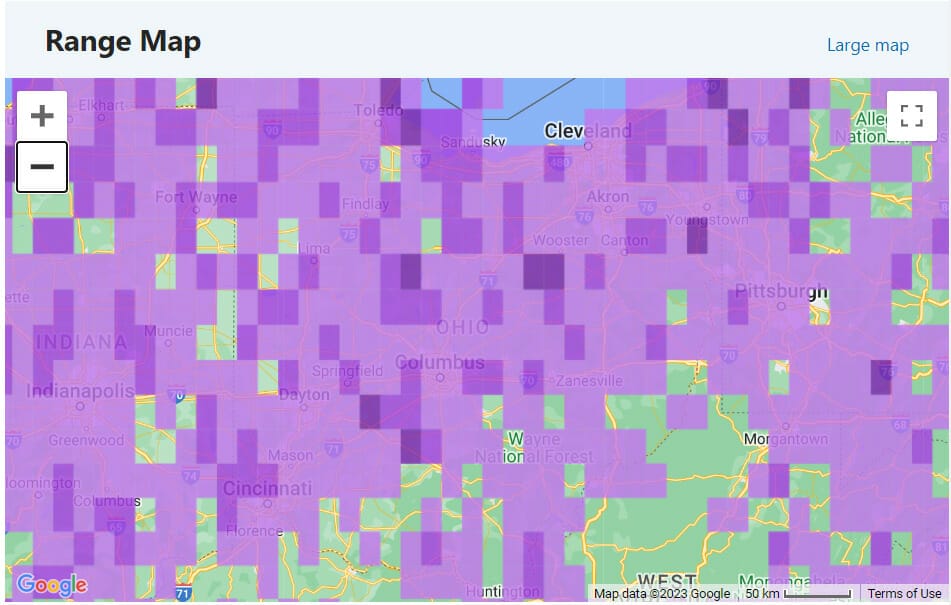
As seen in the eBird range map above and distribution chart below, the Greater Yellowlegs can be seen across most of the state in spring, summer and fall.

Call
Diet
The Greater Yellowlegs looks for aquatic invertebrates. It will also search the shore for them. It has been known to also eat some seeds and berries.
Interesting Fact
This interesting but relatively unstudied wader is sometimes locally known by the names telltale, tattler, and yelper because of its loud alarm calls.
Yellow-throated Vireo (Vireo flavifrons)


Identification and Size
Both sexes are similar with a large bill, olive head and yellow eye ring. The body blends to grey with pale wing bars. The belly is an off white.
Length: 5.1 – 5.9 inches
Wingspan: 9.1 inches
Weight: 0.5 – 0.7 ounces
Distribution

The Yellow-throated Vireo migrates during the winter months but during summer and fall, it is widespread across Ohio.

Call
Diet
The Yellow-throated Vireo generally eats available arthropods but will supplement its diet in winter with seeds and fruits.
Interesting Fact
The male bird shares the nesting duties with the female and will take turns in incubating the eggs and feeding the young.
Yellow-bellied Flycatcher (Empidonax flaviventris)

Identification and Size
The Yellow-bellied Flycatcher is a small, olive green flycatcher with a pale yellow eye ring, throat and belly. Darker wings are complemented with white wing bars.
Length: 5.1 – 5.9 inches
Wingspan: 7.1 – 7.9 inches
Weight: 0.3 – 0.6 ounces
Distribution

The Yellow-bellied Flycatcher is an uncommon bird in Ohio, seen in spring and late summer on its migration.

Call
Diet
Like other flycatchers, the Yellow-bellied Flycatcher is adept at catching insects in flight. It will occasionally eat fruits.
Interesting Fact
The Yellow-bellied Flycatcher only stays in the breeding areas between 2 – 3 months. It has the shortest stay of all the migratory birds in the region.
Yellow-crowned Night-Heron (Nyctanassa violacea)

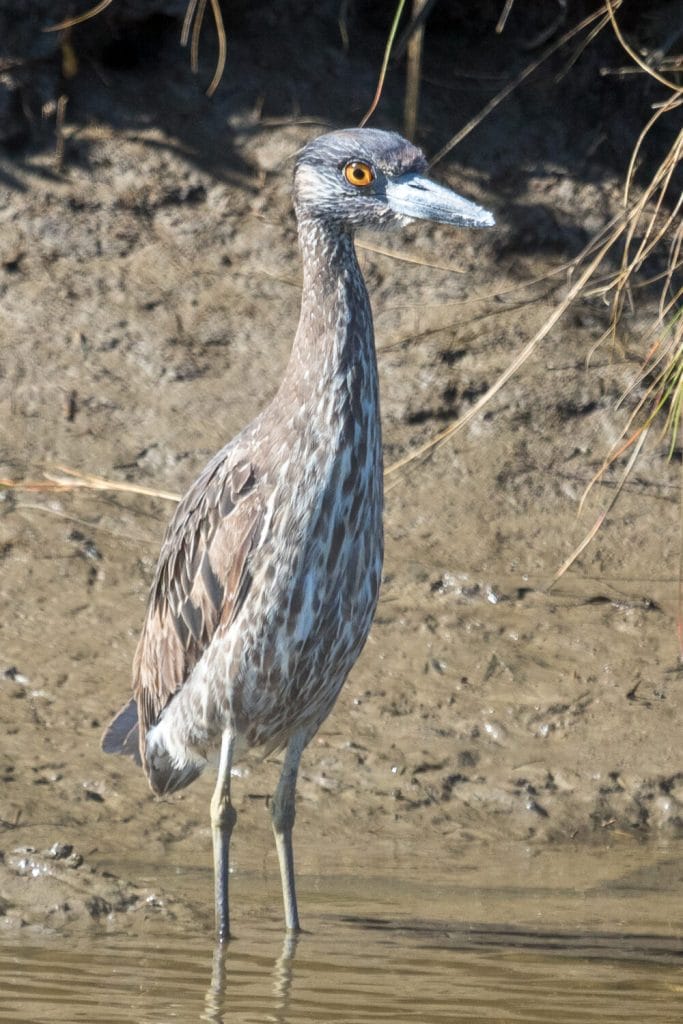
Identification and Size
This medium sized heron is characterized by the large, heavy bill.It also has a big, orange eye. Adult plumage is blue gray and it has pink legs. It has a bright, yellow patch on top of the head, which sometimes raises into a crest.
Length: 21.6 – 27.5 inches
Weight: 22.9 – 28.2 ounces
Distribution

The Yellow-crowned Night-Heron can be seen infrequently in Ohio at any suitable habitat.

Call
Diet
The Yellow-crowned Night-Heron exclusively eats fresh water and salt water crustaceans.
Interesting Fact
The distribution of the Yellow-crowned Night-Heron is dependant on how successful the local populations of crayfish and other crustaceans are. The more of them, the more of the heron.
Eastern Meadowlark (Sturnella magna)

Identification and Size
A large and very distinctive songbird with all yellow underneath and brown/cream patterns on the back. Another yellow patch above the eye. The Eastern Meadowlark is has very long legs and toes.
Length: 7.5 – 10.2 inches
Wingspan: 13.8 – 15.8 inches
Weight: 3.2 – 5.3 ounces
Distribution

The Eastern Meadowlark is resident in Ohio and can be seen throughout the state all year round.

Call
Diet
Searching on the ground, the Eastern Meadowlark looks for insects but will also eat vegetable matter.
Interesting Fact
The Eastern Meadowlark is not a member of the lark family. It is actually a blackbird!
Orchard Oriole (Icterus spurius)


Identification
The Orchard Oriole is unique in that the plumage of the male and female are vastly different but both are very attractive. The male is a combination of black and orange while the female is bright yellow underneath and olive green on top.
Length: 5.9 – 7.1 inches
Wingspan: 9.8 inches
Weight: 0.6 – 1 ounce
Distribution

Seen across the state of Ohio but only in the summer breeding months.

Call
Diet
In migration and breeding periods, the Orchard Oriole eats insects and spiders. At other times it eats ripe fruits.
Interesting Fact
The breeding season is short for the Orchard Oriole and scientists have trouble distinguishing between breeding and migrating birds.
Palm Warbler (Setophaga palmarum)


Identification
The Palm Warbler is a bright yellow warbler with some darker, brown markings on the back and a distinct brown cap.
Length: 4.7 – 5.5 inches
Wingspan: 7.9 – 8.3 inches
Weight: 0.3 – 0.5 ounces
Distribution

Found in forest areas across Ohio during migration times in the spring and fall. Some birds may overwinter.

Call
Diet
The Palm Warbler is insectivorous eating mainly grasshoppers and larvae. During fall and winter, it may take seeds and berries.
Interesting Fact
The Palm Warbler was named such because it was a species first found in the Caribbean. However, it is actually one of the warblers that breeds furthest north.
Nashville Warbler (Leiothlypis ruficapilla)


Identification and Size
A very clean looking warbler, the Nashville species has a plain grey and green back with a yellow front. The white eye ring completes the plumage.
Length: 4.3 – 5.1 inches
Wingspan: 6.7 – 7.9 inches
Weight: 0.2 – 0.5 ounces
Distribution

Found across Ohio in woolands, the Nashville Warbler is another migrant and is seen in spring and fall seasons.

Call
Diet
The Nashville Warbler feeds exclusively on insects and will consume adults and the larvae.
Interesting Fact
Adult birds migrate along usual corridors but young birds prefer to fly along the Atlantic Coast.
Dickcissel (Spiza americana)

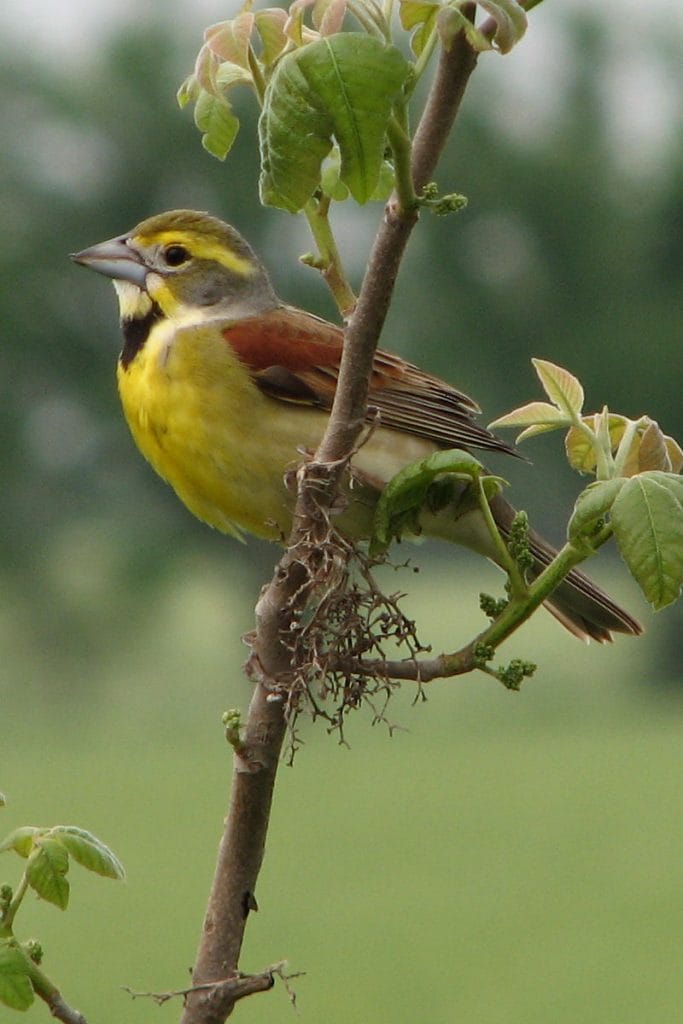
Identification and Size
The male Dickcissel is unmistakable with brown sparrow-like markings on the back and a bright yellow front, black, yellow and white throat and strong yellow eye brow. The female is similar but overall duller.
Length: 5.5 – 6.3 inches
Wingspan: 9.8 – 10.2 inches
Weight: 0.9 – 1.4 ounces
Distribution
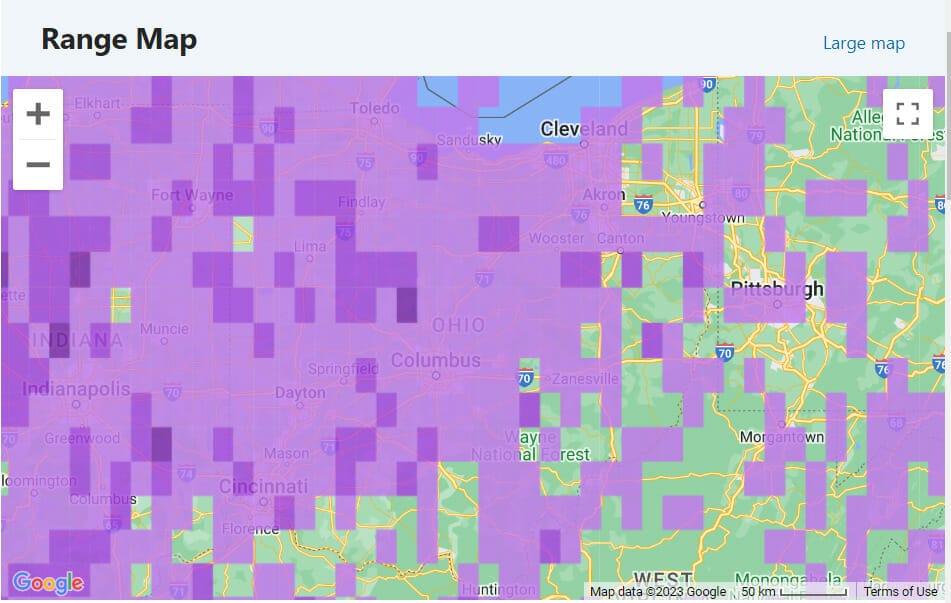
The Dickcissel is present in the summer months in Ohio, although it may be seen at other times through the year. It is present across the state but mainly further west.

Call
Diet
The Dickcissel is omnivorous during the breeding season with the majority of foods taken being animal based. During fall and winter, it becomes granivorous, eating mainly seeds.
Interesting Fact
The Dickcissel is classed as a Cardinal but it has been the subject of much debate. It has previously been classed as a New World sparrow, an oriole and even a blackbird.
FAQs
These could be American Goldfinches. They didn’t make our list but are definitely an attractive yellow bird. They are present in Ohio all year round.
Around 15 years ago, a yellow colored Cardinal visited a bird feeder in Ohio. It caused quite a stir but was not a new species, just a genetic aberration.
25 species of warbler can be seen in Ohio and while some look very similar, there are species that are very different. The waterthrush species and Worm-eating and Swainson’s Warblers are examples.
It was difficult to choose just 10 yellow colored birds in Ohio. Honourable mentions go to the American Goldfinch, Hooded Warbler and Yellow-breasted Chat. We may need a part 2!







